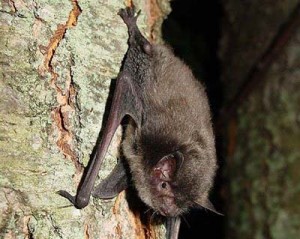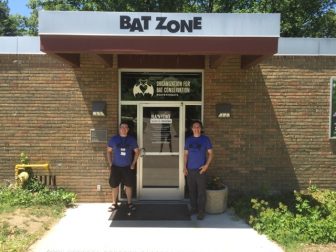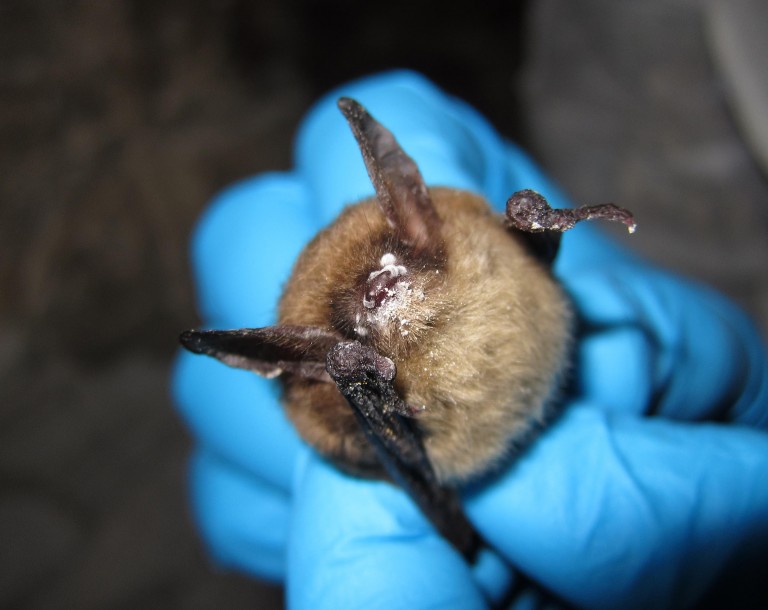By MORGAN LINN
Capital News Service
LANSING — Bat enthusiasts hope to see festivals celebrating the web-winged mammal in every Great Lakes state.

Indiana bat, found in midwestern states. Image: U.S. Fish and Wildlife Service
The original Great Lakes Bat Festival started in Michigan, founded by the Organization for Bat Conservation, a nonprofit group to protect bats and teach about them. The festival celebrated its 15th anniversary two weeks ago and drew more than 3,000 people to Clinton Township.
“We started the bat festival because we realized that it was really important to get all the agencies and bat experts together to educate the public and reach out to the media about how important bats are in the Great Lakes region,” said Rob Mies, the executive director of the Organization for Bat Conservation, based at Cranbrook Indtitute of Science in Bloomfield Hills.
This weekend his group, the U.S. Forest Service and the Wisconsin Department of Natural Resources are putting on one of the biggest bat festivals in the region: the Wisconsin Bat Festival.
They held another one recently in Indiana.
The Wisconsin Bat Festival began eight years ago, after the Great Lakes Bat Festival. The original festival partners are “very interested in expanding and getting more of the whole Great Lakes included,” said Cynthia Sandeno, leader of the threatened, endangered and sensitive species program for the eastern region of the Forest Service.
Many smaller festivals with a couple hundred attendees are starting to pop up at state parks and nature preserves. The Wisconsin Bat Festival is much larger and typically has between 1,000 and 3,000 people.
It has live bats and hands-on activities, such as making bat masks and finger puppets, she said. There will also be a chance to make bat houses out of car parts, a workshop where kids can learn about how scientists use DNA and other fun exhibits and experiences, she said.
Anyone who attends gets $2 off the entry to the Milwaukee Museum, which is hosting the festival.
One of the main goals is to get people excited about bats and combat misconceptions. “So many people are afraid of bats because of myths,” Sandeno said.
If people have bats in their attic or on their property, they’ll often have them killed because they fear them, Mies said. The Michigan festival partnered with Critter Catchers, which removes bats humanely instead of killing them.
The Wisconsin festival gives people the opportunity to see live bats and watch them eat and interact with each other, Sandeno said.
“When people see a live bat, everything changes,” she said. Then they see how small and cute they are, she said. “Their entire view changes.”

The front of Bat Zone, Philip Garofalo left, and Rob Mies right. Image: Eamon Devlin
The Organization for Bat Conservation will bring in native insect-eating bats and other non-native species. The group has a “Bat Cam” which is a live stream of the bats that usually live at its Bat Zone at Cranbrook.
The more people know about bats, the less likely they fear them, Mies said.
Bats need to be protected, because are incredibly important for the environment and people, Sandeno said.
They eat many insects that are crop pests and forest pests, saving farmers on average $23 billion a year, she said. “They’re eating insects that are eating our crops, that means less pesticides being used, meaning healthier crops and healthier food for us.”
One bat by itself can eat up to 5,000 insects every night, Mies said. They are the primary predators of nighttime insects.
Farther south they are important pollinators, he said. A lot of foods, such as bananas, dates, figs and pineapples, are pollinated by bats and then shipped to the Great Lakes region for people to eat.
Bats pollinate more than 500 economically important plants, Sandeno said. They’re also one of the biggest dispersers of seeds, which helps rebuild forests.
And they are interesting in and of themselves.
“They’re the only mammal that can fly, and they’re active at night — and they’re just cool because of that,” she said.
It is now more important than ever that bats are protected. “White nose bat syndrome has killed over six million bats in just six years,” Sandeno said. It’s a fungus that grows on bats and wakes them up from hibernation too frequently, meaning the bats die of starvation.

A northern long-eared bat with white nose syndrome. Image: U.S. Fish and Wildlife Service
Michigan has lost between 30 percent and 50 percent of its bats the last three years, Mies said. In Wisconsin, bats are also in steep decline.
And bats typically only have one baby a year, Sandeno said. Even if the syndrome magically disappears tomorrow, repopulation would be a daunting task.
“We don’t have a cure, we don’t have a treatment yet,” she said. “It’s really terrifying.”
A key message of the Michigan festival, and the upcoming one is that bats are dying very quickly, and now more than ever all bats are important.
Bats in attics may be survivors. “They may be the bats we rely on in the future to help repopulate the state of Wisconsin,” Sandeno said.
Festival-goers can make green bat houses out of recycled car parts, donated by General Motors, she said. The houses will then be put up on U.S. Forest Service land.
“What the bat houses do during the summer, is it gives bats a safe, warm, dry place to raise healthy babies,” Mies said. “The more healthy babies, the more healthy bats that go into hibernation, the more likely they’ll make it through the winter.”
There will also be information about how to build bat houses in your own backyard, Sandeno said.
Another festival activity will be learning how to “garden for bats,” she said. “By planting native plants, providing native trees, you can provide a habitat for bats that’s going to be good for insects, which is really good and healthy for bats.”
There will be a hands-on activity where people can make seed bombs. They are made of clay and native seeds, and you can take them home and plant them in your backyard.
People will also learn which native plants help bats, so they can later buy them and make their own backyard bat garden.
“We can reach a lot of people through the Wisconsin Bat Festival, but it’s still a really small portion of the population in Wisconsin,” she said. “If we can educate these folks and get them excited, they’ll take the message out to their friends and family.”